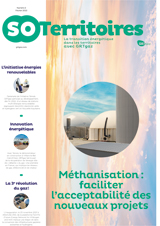The announced regional expansion of low-carbon hydrogen

But what transport model will be used to carry it? And what role will the regions play in the expansion of the sector? These are questions that need answers, and GRTgaz backs the vision of an open, mutualised network that supports the regional ecosystems springing up throughout France.
Hydrogen has never received such close attention.
The war in Ukraine and Europe’s desire to end dependence on Russian gas, which accounted for 45% of EU gas imports in 2021, have only strengthened hydrogen’s position. “We are seeing a genuine acceleration, with European targets increased by a factor of four between 2021-2022,” confirms Geoffroy Anger, head of the GRTgaz Hydrogen Department’s Hydrogen Transport division. This refers, of course, to low-carbon hydrogen – an energy vector seen as a driver of the energy transition, in particular for industry and heavy mobility. France’s hydrogen plan has been in place since 2018. In 2020, it was supplemented by a national strategy for developing low-carbon hydrogen. The goal is to reach an electrolyser capacity of 6.5 GWh by 2030 – an ambition in line with European targets, as reaffirmed last year via the “Fit for 55” reduction package stipulating 55% less CO2 emissions by 2030. And the regions have already made a start.
“Having a universally accessible low-carbon hydrogen and CO2 transmission infrastructure is a key factor in the regions’ future attractiveness, reducing their ecological footprint and growing their economic base.”Geoffroy Anger
Head of the GRTgaz Hydrogen Transport division
A 53,000 km European network by 2040 to connect the hydrogen valleys
With the spotlight falling on hydrogen production and consumption, the pressing question of its transport should become a priority issue for France. In 2020, around 30 European gas transmission network operators, including GRTgaz, came together as part of the European Hydrogen Backbone (EHB) initiative to prepare the hydrogen networks of tomorrow.
The EHB plans for a 53,000 km network by 2040, connecting 28 countries. France is perfectly located at the centre of a “southwest corridor” between the Iberian peninsula and Europe’s industrial centre. It also enjoys links to an interconnected North Sea corridor that would benefit Le Havre or Dunkirk.
Much-needed expertise
Under these conditions, the expertise of a transporter such as GRTgaz is highly in demand.
“From 2026, we will be able to free up the regional natural gas transmission network pipelines and reallocate them to transporting hydrogen,”, confirms Geoffroy Anger.
The company is already taking steps towards this in key zones. Its now-familiar overall strategy is to develop hubs, then connect the basins, then expand to an international interconnection. The concept of regions can be confused with that of basins, some of which, as in the east of France, will be cross-border. At the end of 2021, several industrial companies from France, Germany and Luxembourg founded the Grande Region Hydrogen – a European Economic Interest Grouping (EEIG) spanning Lorraine, Luxembourg and Sarre. Production and consumption potential is sufficiently mature to create a hydrogen transmission network. GRTgaz and two fellow German and Luxembourgish network operators hence joined forces with the MosaHYc (Moselle Sarre HYdrogène Conversion) project to set up 100 km of a network and the first step towards this cross-border partnership, half of which will use the former natural gas pipelines. Commissioning is planned for 2026.
Attractiveness: a challenge for local authorities
Further south, in Alsace, GRTgaz is involved in the RHYn project connecting Germany and Switzerland. In Marseilles, likewise, the Group is a key player in the HYnfraMed project to create a mutualised hydrogen transmission network between Fos-sure-Mer and Manosque. The method is the same for each: bringing regional stakeholders together to co-construct the projects.
“We have to pull together, because a transporter is, by definition, a stakeholder that links supply and demand,” clarifies Geoffroy Anger. “We are promoting a vision that is in the public interest, with open, mutualised networks.” With this expansion beginning on a regional scale, local authorities “have understood the potential attractiveness of hydrogen, both in economic terms and for mobility.” They will have a crucial role to play moving forward.
“The Grande Region Hydrogen European grouping is a genuine collective success, with GRTgaz facilitating dialogue between producers and consumers. “Geoffroy Anger
Head of the GRTgaz Hydrogen Transport division
Key figures
- 10 million tonnes – the renewable hydrogen production target for 2030 announced in May by the European Commission in its new energy transition plan, REPowerEU. A further 10 million tonnes will be imported.
- 60% – the portion of the transmission network converted into hydrogen pipelines by 2040.
Source: European Hydrogen Backbone (EHB) report - A European hydrogen infrastructure vision covering 28 countries, April 2022.
Subscription form for the SoTerritories and soNews newsletters
Publications


